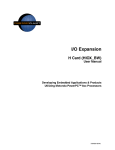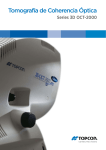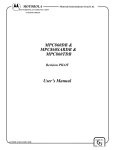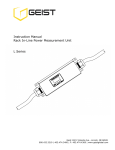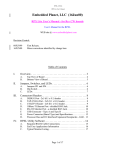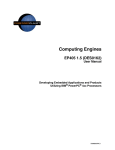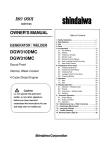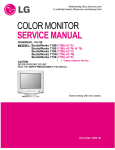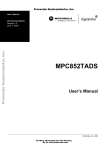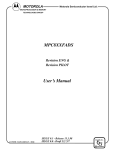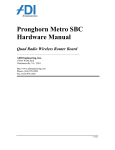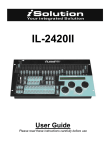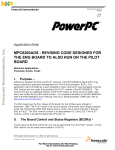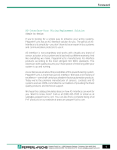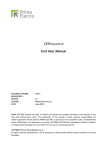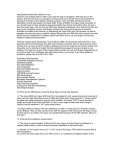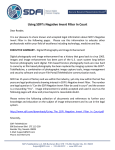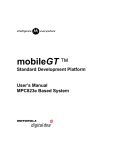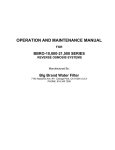Download RPX Lite (LITE_DW), User Manual
Transcript
Computing Engines RPX Lite (LITE_DW) User Manual Developing Embedded Applications & Products Utilizing Motorola PowerPC™ 8xx Processors 700M0006RA0 2 700M0006RA0 Computing Engines, RPX Lite Notice This manual in whole or in part, is to be considered the intellectual property of Embedded Planet. The manual and all information explained and derived there from are protected by the license to which you agreed upon opening this package. This document contains confidential information and is intended for the sole purpose of the end user to develop applications on the RPX Lite product offered by Embedded Planet, LLC. Neither the document, nor reproductions of it, nor information derived from it is to be given to others, nor used for any other purpose other than for RPX Lite applications. No use is to be made of it which is or may be injurious to Embedded Planet, LLC and no use is to be made of it other than for RPX Lite applications. Trademarks Embedded Planet, PlanetTrack, Linux Planet, Blue Planet, RPX Lite, and RPX LICC are trademarks or registered trademarks of Embedded Planet. PowerPC is a trademark of International Business Machines. All other names and trademarks are the property of their respective owners. 700M0006RA0 3 Computing Engines, RPX Lite 4 700M0006RA0 Computing Engines, RPX Lite Contents Chapter 1 Introduction .......................................................................................................... 7 Functions .........................................................................................................................................7 How to Use This Manual ..............................................................................................................9 Reference Documents ..................................................................................................................10 Chapter 2 Setup ................................................................................................................... 11 Strapping .......................................................................................................................................11 Dipswitch ......................................................................................................................................11 Chapter 3 Connectors and Headers ................................................................................... 13 DEBUG Port ..................................................................................................................................13 TAP (JTAG) Port ...........................................................................................................................13 UTILITY Header ...........................................................................................................................14 Ethernet Port .................................................................................................................................14 Monitor Port ..................................................................................................................................15 USB Port .........................................................................................................................................15 Power Connector ..........................................................................................................................16 Power Options .......................................................................................................................16 Considerations .......................................................................................................................16 Bus and I/O Interface Expansion Connectors .........................................................................16 Chapter 4 Operation ............................................................................................................ 19 Board LEDs ...................................................................................................................................19 Ethernet Port LEDs ......................................................................................................................19 Chapter 5 RPXL Versus LITE .............................................................................................. 21 Chapter 6 Utility Software ................................................................................................... 23 RS-232 Cable Connections ..........................................................................................................23 User Applications Information ..................................................................................................24 List of Figures No. 1-1. 1-2. 6-1. 6-2. 700M0006RA0 Title Page RPX Lite Board - Top View ..............................................................................................8 RPX Lite Board - Bottom View........................................................................................9 RS-232 Cable Connections - Null Modem...................................................................23 RS-232 Cable Connections - RJ-45 to DB9 Cable ........................................................24 5 Computing Engines, RPX Lite List of Tables No. 1-1. 1-2. 2-1. 2-2. 3-1. 3-2. 3-3. 3-4. 3-5. 3-6. 3-7. 4-1. 4-2. 6 Title Page Hardware Features ...........................................................................................................7 Reference Documents.....................................................................................................10 Strapping..........................................................................................................................11 Dipswitch Settings ..........................................................................................................11 DEBUG Port Pinout (P6)................................................................................................13 TAP (JTAG) Port Pinout (P7) ........................................................................................14 UTILITY Header Pinout (P14) ......................................................................................14 Ethernet Port Pinout (PE3) ............................................................................................15 Monitor Port Pinout (PM3)............................................................................................15 Type A USB Port Pinout (P4) ........................................................................................15 Type B USB Port Pinout (P5).........................................................................................15 Board LED Definition.....................................................................................................19 Ethernet LED Definitions ..............................................................................................19 700M0006RA0 Introduction Chapter 1 The RPX Lite (LITE_DW) is a highly integrated single-board computer (SBC) based on the Motorola MPC850 and MPC823. The MPC850 versions are targeted for the telecommunications industries, while the MPC823 version is targeted for the industrial controls market. Support is available from Embedded Planet or from third-party vendors for several commonly used real-time operating systems (RTOS). The RPX Lite is in a PC104 board form factor (Figs. 1-1 and 1-2). It does not contain PC104 (ISA) or PC104+ (PCI) functionality, but rather adheres to the mechanical specifications of the PC104 standard. For PC104 (ISA) or PC104+ (PCI) requirements, refer to the RPXC User Manual. Functions The functions included on the RPX Lite are listed in Table 1-1. For programming information, refer to the RPX Lite Programmer’s Firmware Manual. Table 1-1. Hardware Features Entity Function Processor MPC850 (SR, DE, etc.) or MPC823E SDRAM 16, 32, or 64 Mbytes FLASH 2, 4, 8, or 16 Mbytes NVRAM/RTC 0, 32, 128, 512 Kbytes Ethernet port SCC2 - 10BaseT (RJ-45) Monitor port SMC1 - 3-wire RS-232 (RJ-45) Serial EEPROM I2C Serial temperature and thermal monitor I2C Debug Development port header for BMD TAP TAP header for test and JTAG PCMCIA Single slot - Type I, II, or III USB Type A or type B connector Dipswitch 4-position slide switch read via status register LEDs Two user-programmable via control register 1 700M0006RA0 Bus expansion receptacle Processor bus interface expansion receptacle I/O expansion receptacle1 Processor I/O interface expansion receptacle 5 VDC supply (optional 3.3 VDC supply) Single power supply source for board (board draws 1A maximum) 7 Chapter 1 - Introduction Computing Engines, RPX Lite Table 1-1. Hardware Features (continued) Entity Function BCSR2 Control and status register (BCSR0, 1, 2, 3) NOTES: 1. The expansion receptacles allow for daughter cards supporting such functions as CAN, ARCNET, T1/E1, xDSL, PCI via PC104+, etc. 2. Refer to the RPX Lite Programmer’s Firmware Manual for a description of the BCSR registers. BUS EXPANSION UTILITY HEADER DEBUG PORT TAP PORT I/O EXPANSION D P14 T P6 P7 TP1 A1 B1 A1 TP2 B1 P2 P1 ETH RO5R PE3 ROB3 ROA3 RG1 P5 P4 MON PM3 RO6 P16 CR14 MONITOR PORT (SMC1) ETHERNET PORT (SCC2) USB A USB B 5 VDC T00011A Figure 1-1. RPX Lite Board - Top View 8 700M0006RA0 Computing Engines, RPX Lite Chapter 1 - Introduction PCMCIA P10 RNB12 2 3 RO2J 1 ON 4 RNA12 SW1 RO1 CR6 CR1 RO2D CR3 CR8 CR2 T00019A Figure 1-2. RPX Lite Board - Bottom View How to Use This Manual 1. Refer to Chapter 2 for setup information including strappings and dipswitch settings. 2. Refer to Chapter 3 for a description of the connectors and headers available on the RPX board. 3. Refer to Chapter 4 for a description of the LED indications for the RPX board and Ethernet port. 4. Read Chapter 5 for an explanation of the differences between an RPXL_CW and LITE_DW board. 700M0006RA0 9 Computing Engines, RPX Lite 5. Read Chapter 6 for a description of the utilities included with the RPX board (i.e., PlanetCore). Reference Documents Table 1-2 lists additional Embedded Planet documents for the RPX Lite board. Table 1-2. Reference Documents Document Number 10 Description 700M0002R__ PlanetCore, Diagnostics and Utilities (Release 1) 700M0003R__ PlanetCore, Boot Loader 700M0004R__ PlanetCore, Flash Burner 700M0007R__ RPX Lite, Programmer’s Firmware Manual 700M0014R__ PlanetCore, Diagnostics and Utilities (Release 2) 700M0028R__ RPX Lite, Expansion Card Design Guidelines 700M0006RA0 Setup Chapter 2 This chapter describes the various strappings and dipswitch settings that setup the LITE_DW board for operation. The straps are zero ohm, surface-mount resistors. The dipswitch has four positions. Strapping Table 2-1 describes the various strap settings; refer to Figures 1-1 and 1-2 for the locations of the straps. Table 2-1. Strapping Purpose Strap Function DEBUG RO2D Debug port on processor active (P6) JTAG RO2J JTAG chain active (P7) 5 VDC monitor RO5R Populated = 5 VDC supply monitored for an out of tolerance condition. Not populated = 5 VDC supply not monitored for an out of tolerance condition. Earth ground RO6 Populated = EARTH_GND connected to digital ground at one point. Not populated = EARTH_GND not connected to digital ground. SMC1 ROA3 RS-232 transceiver drives the DTR# true all the time (5 VDC minimum at 1.67mA). ROB3 5 VDC rail drives the DTR# signal all the time (for powering IR keyboards). Dipswitch The four-pole dipswitch (SW1) located on the board is readable via the onboard status register. The switch is intended for use by specific customer applications. Table 2-2 describes the switch settings; refer to Figure 1-2 for the location of the dipswitch. Table 2-2. Dipswitch (SW1) Settings Pole Positions Function 4321 D(27:24) 0000 or 1111 Normal operating mode 0001 Reserved for manufacture test 0010 Reserved for fallback mode 0011 through 1110 User specified NOTE: down = on = closed position will read back a logic 0 in the status register. up = off = open position will read back a logic 1 in the status register. 700M0006RA0 11 Computing Engines, RPX Lite 12 700M0006RA0 Connectors and Headers Chapter 3 The LITE_DW board contains: One RJ-45 connector with integrated LEDs for the Ethernet port. One RJ-45 connector for the RS-232 monitor port. One USB connector (either type A or Type B). One barrel connector for power. Two daughter card bus and I/O expansion receptacles. Three headers for auxiliary functions. • • • • • • This chapter describes these connectors and headers. Refer to Figure 1-1 for the locations of these connectors and headers. DEBUG Port The DEBUG port is identified with the letter D on the silkscreen (middle header P6). It is a 2 × 5 (0.1 × 0.1) header. When RO2D is populated to select this mode, the TAP (JTAG) chain on the board is disconnected, and the DEBUG port is dedicated to the processor. Refer to Table 2-1 for a description of RO2D. Table 3-1 shows the DEBUG port pinout. NOTE: No mating connector should be attached to the TAP port (P7) when this mode is active. Table 3-1. DEBUG Port Pinout (P6) Pin Function Pin Function 9 7 5 3 1 +3.3V HRST# GND GND FRZ 10 8 6 4 2 DSDO DSDI FRZ DSCK SRST# NOTE: Pin numbering 1 through 10 as shown in table is when looking down onto the header. TAP (JTAG) Port The TAP (JTAG) port is identified with the letter T on the silkscreen (right header P7). It is a 2 × 5 (0.1 × 0.1) header. When RO2J is populated to select this mode, the TAP (JTAG) chain on the board is completed. The chain is processor first, then the CPLD device. Refer to Table 2-1 for a description of RO2J. Table 3-2 shows the TAP port pinout. NOTE: No mating connector should be attached to the DEBUG port (P6) when this mode is active. 700M0006RA0 13 Chapter 3 - Connectors and Headers Computing Engines, RPX Lite Table 3-2. TAP (JTAG) Port Pinout (P7) Pin Function Pin Function 9 7 5 3 1 TCK TMS TDO TDI TRST# 10 8 6 4 2 GND GND +3.3V GND GND NOTE: Pin numbering 1 through 10 as shown in table is when looking down onto the header. UTILITY Header The UTILITY header is the left header (P14). It is a 2 × 8 (0.1 × 0.1) header. The utility header is used to allow for external connections. Three types of reset signals can be connected to the header: hard reset, soft reset, and power on reset. Table 3-3 shows the UTILITY header pinout. Table 3-3. UTILITY Header Pinout (P14) Pin Function Pin Function 15 13 11 9 7 5 EBAT — +12.0V — 16 14 12 10 8 6 GND GND GND GND GND GND PFIRQ0# SRST# 3 1 POR# HRST# 4 2 GND GND NOTES: 1. Pin numbering 1 through 16 as shown in table is when looking down onto the header. 2. Signals HRST#, POR#, and SRST# must be open drain or open collector type signals. 3. Pins 1, 3, 5, and 7 are input signals (digital 3.3 VDC signals). 4. Pins 11 and 15 are input voltage signals (voltages that can be supplied to these pins). 5. Pins 9 and 13 are currently no connects. The PFIRQ0# signal is routed to interrupt level 0 on the processor and could be used as a Power Fail Interrupt signal. The 12.0 VDC signal is used for PCMCIA cards that require 12.0 VDC. 12.0 VDC is not used anywhere else on the LITE_DW board. The EBAT signal is for connecting an external battery to back up the real-time clock and keep alive power circuits inside the processor. The onboard NVRAM/ RTC has its own battery and is not associated with the EBAT signal. The EBAT signal does not have any connection to the supplies powering and operating the board. When no external battery is connected to the EBAT signal, a jumper should be connected across pins 15 and 16. Ethernet Port The Ethernet port is identified by the reference designator PE3 and the letters ETH. It is a shielded RJ-45 jack with integrated LEDs. Table 3-4 shows the 10BaseT RJ-45 jack pinout. The RJ-45 connector is shielded and tied to EARTH GROUND. The Ethernet port is from SCC2. 14 700M0006RA0 Computing Engines, RPX Lite Chapter 3 - Connectors and Headers Table 3-4. Ethernet Port Pinout (PE3) Pin 8 7 Function 6 5 4 RXD- 3 2 1 RXD+ TXD- TXD+ NOTE: Pin numbering 8 down to 1 is from left to right when looking into the RJ-45 jack (locking tab on top). Monitor Port The RS-232 monitor port is identified by the reference designator PM3 and the letters MON. It is a shielded RJ-45 jack. Table 3-5 shows the RS-232 RJ-45 jack pinout. The RS-232 Monitor Port connector is shielded and tied to EARTH GROUND. The signals listed in the table are surge protected, with the transient voltage suppressors connected to EARTH GROUND. The monitor port is from SMC1. Support of the handshake signals RTS# and CTS# is via the BCSR. Table 3-5. Monitor Port Pinout (PM3) Pin 1 2 Function 3 4 5 6 7 8 DTR# GND RXD TXD CTS# RTS# NOTES: 1. Pin numbering 1 through 8 is from left to right when looking into the RJ-45 Jack (locking tab on bottom). 2. RTS# can be driven by the BCSR. 3. CTS# can be received by the BCSR. 4. DTR# can be driven, via strapping option, by the RTS# signal or by the system 5 VDC supply. USB Port The USB port is either P4 or P5 depending on the type of connector installed: Type A or Type B. Only one type of connector is installed on the board. The Type A and Type B connectors are dual-footprints on the PCB, and as such, the type of connector is a manufacturing option specified at the time of order. Table 3-6 shows the Type A USB port pinout; Table 3-7 shows the Type B USB pinout. Table 3-6. Type A USB Port Pinout (P4) Pin Function 1 2 3 4 +5.0V DATA- DATA+ GND NOTE: Pin numbering 1 through 4 is from left to right when looking into the connector. Table 3-7. Type B USB Port Pinout (P5) Pin Function Pin Function 2 DATA- 1 +5.0V 3 DATA+ 4 GND NOTE: Pin numbering 1 through 4 as shown in table is when looking into the connector. 700M0006RA0 15 Chapter 3 - Connectors and Headers Computing Engines, RPX Lite Power Connector The power connector is a barrel type connector. The specifications for the mating connector are as follows: Inner diameter = 2.5mm (0.100 inches) Outer diameter = 5.5mm (0.218 inches) Barrel Length >/= 9.5mm (0.375 inches) Outer shell is GND Inner shell is +5.0V Power Options Two options exist for powering the LITE_DW board: • 5 VDC can be supplied through either the barrel connector or through the expansion receptacles via an Expansion Card. • 3.3 VDC can be supplied through either the barrel connector or through the expansion receptacles via an Expansion Card. NOTE: The option selected must be specified at time of ordering the product because the option selected is assembly dependent. If the 3.3 VDC option is selected, then the following limitations apply: 1. The USB VCC rail on the USB connector cannot be powered with 5 VDC from the LITE_DW board, since 5 VDC is not available on the board. Another source must be used to power the 5 VDC line on the connector side. Aside from the 5 VDC supply issue on the USB connector, USB functionality is still supported. 2. 5 VDC PCMCIA cards are not supported, since 5 VDC is not available on the LITE_DW board. Considerations The DC supply must be a regulated +5 VDC, ±5% supply when using the 5 VDC power option. The 3.3 VDC power option requires a 3.2 to 3.4 VDC supply. The LITE_DW board itself, fully configured but with no expansion cards or PCMCIA cards, draws 1.0 A maximum at VCC = 4.75 VDC to 5.25V DC, T = 0oC-70oC. Bus and I/O Interface Expansion Connectors The processor bus expansion receptacle is the connector strip on the left side identified as P1. The processor I/O expansion receptacle is the connector strip on the right side identified as P2. They are 2 × 60 (B8 Type) receptacles. This interface allows daughters cards to be designed and interfaced to the LITE_DW board. All required signals are routed to the receptacle to allow for daughter cards that require the processor interface. Pins A1 (on left) and B1 (on right) are identified on the PCB. The connector type chosen allows for variable stacking heights and is an 8 mm pitch connector. The standard LITE_DW product board to board mating distance is 16 mm. Available stacking heights range from 4.5 mm to 20 mm. The receptacle part number used on the standard product is AMP 5-179010-5. The standard mat- 16 700M0006RA0 Computing Engines, RPX Lite Chapter 3 - Connectors and Headers ing connector (plug) is AMP 179031-5, which would be used on Expansion Card designs. For signal loading considerations, refer to the Expansion Card Design Guidelines manual. Important The bus expansion receptacle (P1) or interface must be a 3.3 VDC only type of interface (the I/O is not 5.0V I/O tolerant). The I/O expansion receptacle (part of P2) or interface is currently 5 VDC tolerant, but indications from the Motorola Semiconductor Sector claim that future processors will not be 5.0 VDC tolerant on I/O pins. Therefore, it is highly recommended that I/O interfaces on daughter cards be designed for true 3.3 VDC operation. For the pinout of the P1 and P2 receptacles, refer to the pinouts document associated with the board. Pages 1 through 3 of the pinout file are for the RPXC and CLLF (860/821 based) and pages 4 and 5 are for the LITE_DW (850/823 based). 700M0006RA0 17 Computing Engines, RPX Lite 18 700M0006RA0 Operation Chapter 4 This chapter describes the LED indications. Board LEDs Table 4-1 describes the indications for the RPX board LEDs; refer to Figures 1-1 and 1-2 for the locations of the LEDs. Table 4-1. Board LED Definition LED LED Definition When On Color CR1 3.3 VDC power applied Green CR2 Status LED4 Red CR3 Status LED5 Red CR6 Processor activity (BB# signal) Green CR8 Processor hard reset active Red CR14 5 VDC power applied Green NOTE: CR14 is on top side of the board and all others on the bottom side. Ethernet Port LEDs Table 4-2 describes the indications given by the Ethernet port LEDs. These LEDs are integrated into the Ethernet port (ETH). Table 4-2. Ethernet LED Definitions State Indication Left LED Right LED Off Link integrity bad No RXD or TXD activity Yellow Link integrity good and 10Mbps Ethernet RXD or TXD activity and half-duplex Ethernet Green Link integrity good and 100Mbps Ethernet1 RXD or TXD activity and full-duplex Ethernet NOTE: 1. 100Mbps Ethernet is currently not supported. 700M0006RA0 19 Computing Engines, RPX Lite 20 700M0006RA0 RPXL Versus LITE Chapter 5 This chapter explains the differences between the previous RPXL_CW board and the LITE_DW board. The differences and changes are: DRAM Replace 16 Mbytes of EDO DRAM with 16, 32, or 64 Mbytes of SDRAM. SMC1 • Control provided for the RTS# and CTS# signals for handshaking purposes. • DTR# can be driven by RTS# or the system 5 VDC supply. • RTS# is in BCSR1.8. • CTS# is in BCSR1.9. • DTR# via strapping option. • RPXL_CW requires bit swapping to support the NVRAM/RTC. • RPXL_CW does not support IRQ capability from the NVRAM/RTC. • IRQ from the NVRAM/RTC in BCSR3.30 and can be enabled on IRQ4# via BCSR2.23 NVRAM/RTC Ethernet LEDs USB Board mounted LEDs for the Ethernet circuit are removed and included in the RJ-45 connector. Host mode USB supported via the recommended Motorola external hardware fix. • P2 Expansion BCSR2.21 enables the required external USB host mode hardware support. Modification to P2 expansion pinout: • RPXL_CW brought up miscellaneous voltages on the P2 expansion connector. • LITE_DW replaces the miscellaneous voltages on P2 with the AT[0..3] signals as follows: P2.A52 was 12V, is AT2 P2.B51 was 12V, is AT3 P2.A55 was VP, is AT0 P2.B54 was VM, is AT1 • 700M0006RA0 Expansion cards that require miscellaneous supply voltages must provide a means for connecting that supply directly to the expansion card. 21 Computing Engines, RPX Lite 22 700M0006RA0 Utility Software Chapter 6 The LITE_DW board, in its simplest form, is shipped with Embedded Planet boot-up and diagnostic software known as PlanetCore. This code verifies the integrity of the hardware, allows configuration changes, and allows downloading of user code. Additional functionality will be added to this code, and as the additional functionality becomes available, the program will be updated, and is available from Embedded Planet. Upgrades are provided as files containing Motorola s-records. The s-record data is a program which is downloaded to DRAM either using the monitor serial port and a terminal emulation program, or using the Ethernet port and a TFTP server. Once downloaded, the program runs and replaces the regions of FLASH containing the current code. Refer to the PlanetCore User Manuals for information about the PlanetCore boot loader, flash burner, and diagnostics and utilities. RS-232 Cable Connections An RJ-45 to DB9 or DB25 cable is most likely required. Table 3-5 provides the pinout of the RJ-45 connector. A null modem type of connection will be required when interfacing to a DTE port. The LITE_DW board has its serial port wired as DTE. TXD RXD GND DB9 NULL MODEM (DB9) 1 2 3 4 5 6 7 8 3 3 2 5 2 5 (DB9) Figure 6-1 is an example showing two DB9 DTE ports connected (null modem used). Figure 6-2 is an example showing two DB9 DTE ports connected (RJ-45 to DB9 cable integrates null modem connection). 3 3 - TXD 2 2 - RXD 5 5 - GND DTE PORT T00020A Figure 6-1. RS-232 Cable Connections - Null Modem 700M0006RA0 23 Computing Engines, RPX Lite (DB9) 1 2 3 4 5 6 7 8 (DB9) Chapter 6 - Utility Software TXD RXD GND 3 3 - TXD 2 5 2 - RXD 5 - GND DTE PORT T00021A Figure 6-2. RS-232 Cable Connections - RJ-45 to DB9 Cable For DTE: DB9-3 = TXD DB9-2 = RXD DB9-8 = CTS DB9-7 = RTS DB9-5 = GND DB25-2 = TXD DB25-3 = RXD DB25-5 = CTS DB25-4 = RTS DB25-7 = GND User Applications Information The utility code assumes the board is connected to a dumb terminal or a PC-based terminal emulator, and requires user intervention for the diagnostics. The dumb terminal or PC serial port should be set as follows: 9600 baud (default). 8 data bits. 1 stop bit. No parity. No hardware handshake. • • • • • Proper interfacing to the monitor port via the correct RS-232 connections must be insured as described in RS-232 Cable Connections in this chapter. The dumb terminal or PC serial port might require the CTS# signal to be true. In this case, the RTS# signal, which is driven true from the monitor port, should also be connected in the cable path to the CTS# signal on the dumb terminal or PC serial port. NOTES: 1. The DRAM test is a destructive test. 2. 24 The FLASH and NVRAM tests are non-destructive tests. 700M0006RA0 Computing Engines, RPX Lite 25 700M0006RA0 Computing Engines, RPX Lite Embedded Planet 749 Miner Rd. Cleveland, Ohio 44143 www.embeddedplanet.com Form 700M0006RA0 Litho in U.S.A. Oct2000 Copyright © 2000 Embedded Planet, LCC. All Rights Reserved. Phone: 440.646.0077 Fax: 440.461.4329 Toll-Free: 877.468.6899


























